
The History of PART the Police Amateur Radio Team of Westford
By Bo Budinger WA1QYMThe History of PART on YouTube (part 1) (part 2) (part 3)
March 2004
The Real Beginnings
Former Westford Police Chief Joseph Connell initially conceived the idea for the Police Amateur Radio Team. Chief Connell became aware of amateur radio and 2 meter FM mobile in particular though association with his close friend Bud Hill (K1PD). The first meeting between Chief Connell and local ham radio operators took place in the summer of 1975. The most active local ham radio club at that time was CARA the Chelmsford Amateur Radio Association. Several CARA members notably: Jim Dossett (K1TIH) Alice Dossett (WA1URK), Bud Hill (K1PD), and Bo Budinger (WA1QYM) along with Tom Hughes (AG1I), and Frank Karkota (K1RZK) attended most of the initial meetings. During these first few meetings we tried to decide what we were supposed to be doing. Chief Connell wanted “more eyes in the town”. He felt that those of us who have 2 meter FM in our cars could be these additional “eyes” and report accidents and other police reportable incidents back to the police station just as his cruisers do. We had to sort out how to do this and still operate within the rules and regulations of Amateur Radio.In those early days we also struggled with how we would interact with the Westford Police. There were suggestions of a “Police Cadet Program” that would include us hams. This did not go over well with anyone. We also worked very hard to determine a name for ourselves. We finally decided on PART, The Police Amateur Radio Team.
We quickly identified the initial requirements to get PART going. We felt that we needed publicity, both in the community and within the local ham fraternity itself. We needed a 2 meter rig to be placed in the dispatch area of the Police Department and many operators to man the rig in the station.
PART Becomes Known
We got our first bit of publicity when Ralph Jacobs of the Lowell Sun wrote a full page article on PART (with a picture of Bud Hill sending Morse code). This article covered the whole last page of the first section of the Sunday Lowell Sun on January 27, 1976.PART started its now famous “Pumpkin Patrol” back in 1977. It has been one of the cornerstones of our yearly operating schedule ever since. Both the Westford Eagle and the Lowell Sun have written articles describing our activities on Halloween in support of the Westford Police.
PART was quite fortunate in those early days in another way. A local Motorola sales representative by the name of Dave McKenzie loaned us a $1300 base station. We set the rig up in the police station on 146.52 MHz. Dave loaned the rig to us on an approval basis expecting eventually to make a sale. The Massachusetts State Office of Public Safety had set aside money for local police departments to purchase citizen band rigs for their station. Chief Connell petitioned the Office of Public Safety for the purchase of the Motorola rig through this plan. I am sure he had some explaining to do because he petitioned for the expensive Motorola rig when the average CB rig was going for less than $200. The state accepted his petition and sent out a request for bid on the rig. We carefully wrote the specifications for this bid to exactly match those of the Motorola rig. Much to our surprise, Dave did not get this sale as he was underbid by GE. This is how we came to possess the GE rig that is still in the police station today.
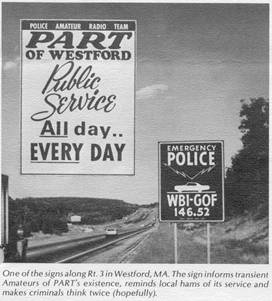
There is an interesting story behind the WB1GOF signs on I-495 and State Route 3. Chief Connell petitioned the State Department of Public Works in March of 1978 to place four signs on these roads. The signs would be at the Westford town borders for the purpose of alerting hams that WB1GOF existed. The State DPW did not quite know how to deal with this request as there was no real precedence for this type of sign. It was almost impossible to get any unique type of sign erected on an interstate highway due to the extensive list of restrictions imposed by the federal government. The State DPW dragged their feet for almost a year without giving us the approval we wanted. The DPW Board of Directors reviewed our request but did not approve it. They did indicate that if they were to approve it we would have to pay for the signs. In the interim we were able to raise about $2000 to cover the cost of four signs. Finally, in February of 1979, nearly a year later, Chief Connell wrote Governor King of Massachusetts about our plight. Governor King, in turn, sent our request to the attention of the Commissioner of Public Safety. He gave his approval to our project and sent our request to the Secretary of Public Safety who finally put pressure on the state DPW to do something about our signs. Finally in the Fall of 1980, more than two years after our original request, the state DPW erected the blue and white WB1GOF signs AT THEIR EXPENSE! Because of all the legislative bumbling we didn’t pay for either the signs or the expense of erecting them. As a result we took the money set aside for these signs and ordered 10 smaller versions that were placed at the major local roads entering Westford.
WB1GOF is launched
So, we were all set. We had the rig in place and the publicity underway. It was decided to have a formal dedication of WB1GOF at the Police Station. On January 26, 1980, Dennis Condon of the Massachusetts Department of Public Safety opened WB1GOF for operation in a formal ceremony at the Police/Fire Station. Many State and local dignitaries were in attendance along with a good representation from the local ham radio community.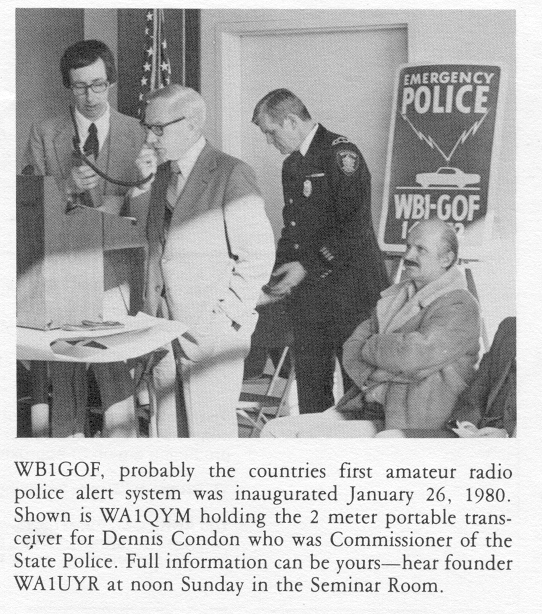
We were really not sure on how to deal with emergency calls from amateurs into the station. Our first reaction was that we would all monitor from home particularly at night and when a call came into WB1GOF we would answer it from home and telephone the police station. We did not realize that several local daily QSO’s took place in the middle of the night on 146.52. This did not sit well with some XYL’s who also had to listen in. So we dropped that concept. During the day, Chief Connell had a mike and speaker extension place in his office so he could respond to calls during working hours as by this time Joe had passed code and theory tests and was awarded the call sign WA1UYR.
The vast majority of calls to WB1GOF came during commute time. So, we instituted monitoring at the police station by local hams during these hours of the day. This proved to be very successful as it allowed the ham community access to the police station as well as “showcased” ham radio communications to the overall police department. In the end, we had to rely on the credibility of police dispatchers as well as the general rule that unlicensed people (such as dispatchers) can use amateur radio in emergency situations.
WB1GOF proved to be much more widely used than we ever expected. We received emergency calls not only from Westford but from locations all up and down 495 and Route 3 as well as the occasional call from New Hampshire and Route 128. A breakdown of the 196 calls received by WB1GOF in its first year of operation showed that the majority of calls dealt with road hazards such as disabled vehicles and debris. Several were reports of motor vehicle accidents and fires. One report dealt with a personal assault in progress while another was a report (later verified) of a cargo plane crash north of Westford.
As knowledge of the existence of WB1GOF spread, more and more calls came in to the Westford Police Station. During the early 1980’s we averaged over a call a day. I remember, at one time, receiving six emergency calls while monitoring WB1GOF from the police station on a particularly snowy and stormy evening. With the advent of cell phones and the capability to call directly to local and State Police through the PART repeaters, the use of WB1GOF has tapered off considerably.
Field Days
PART began to expand into a more conventional ham radio club once we had established a well operating system for reporting calls into WB1GOF. Our first club Field Day was in the summer of 1985. We operated from the back yard of Dave Meyer’s (KA1BM) house at the top of the hill on Boston Road. It was quite a success. We had a number of Field Days from Dave’s spacious location since then. More recently we have had successful Field Days in the rear of the Abbott Middle School. It has always been very gratifying to see Field Day as one of the key yearly events in PART’s calendar. 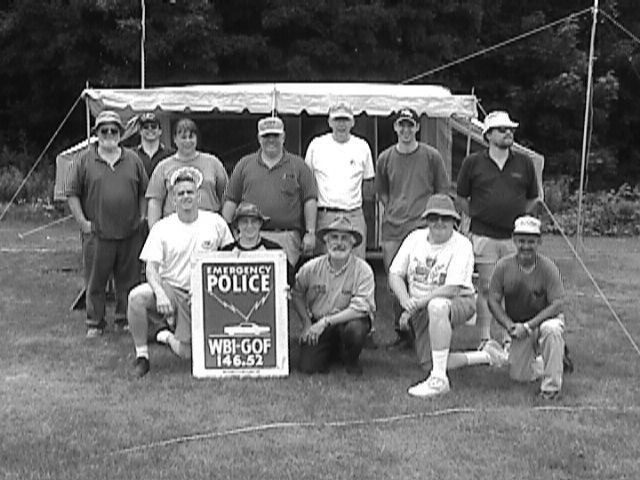
One of the most
notable events during one of these Field Days was the
use of twin helium filled weather balloons to put up a
20 meter Sterba Curtain. This was a large
antenna strung between the two 20 foot diameter
balloons tethered at either end of the Field Day
site. In the middle of the night, while we were
all busily making contacts, one of the balloons broke
loose from its moorings and sailed away in the general
direction of Boston. We seemed to make better
contacts with one end of the antenna on the ground
once we lost this balloon. We released the
second balloon at the end of Field Day.
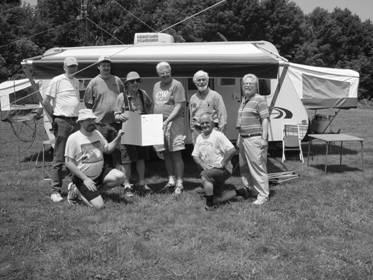
The PART Field Day crew poses for a group picture in
2001
Publicity
The Lowell Sun has been particularly good to PART over the years by featuring PART and PART members in several well written articles. Ed Manzi wrote a front page article on ham radio and the first invasion of Iraq back in 1991. The title of the article was “Hamming it up: Radio operators first line of defense, America’s ears in the Gulf” (can you believe this?). PART members Terry Stader (KA8SCP), Tom Hughes (AG1I), and Bo Budinger (WA1QYM) were featured in a picture on the front page of the Lowell Sun in support of this article. It appears that the Lowell Sun was desperate to find local color articles with relevance to the beginning of the first Gulf War.One of the more interesting PART projects involved work with Bob Ricciardelli, an electronics teacher at Westford Academy. We were able to set up a ham radio station in the Academy through the help of Bob and through the contributions of ham gear from several of our members,. A few Academy students had their technician license but had no equipment or place to operate. Bob provided the area and we provided the gear which consisted of a 25 watt 2 meter FM transceiver and J pole antenna. We also located an old HF receiver. A dipole was strung along the roof of the Academy for this receiver. Academy students used the 2 meter gear to talk mainly on local repeaters but made one contact which gained them much notoriety. The Space Shuttle Atlantis was circling the earth and had 2 meter ham radio aboard. The astronauts were quite active on 2 meters and the Academy students were very excited to make a contact with Atlantis. Unfortunately, pass after pass of Atlantis went by with not contact. The Academy station was constantly “outgunned” by larger stations. Finally, in one of its last passes over the USA contact was made. It was a brief contact just as Atlantis dipped below the eastern horizon over the Atlantic Ocean. Academy students were ecstatic. The Lowell Sun published a great article on the contact. The students who made this historic contact were: Adam Pfeifer (KB1ICD), Eric Pfeifer (N1JUR), Doug Barnett (N1JSJ), Tony Vallance (N1HXM) and Dave Vallance (N1HXL).
The Modern Era
I like to think of the time between about 1983 and today as the modern era of PART. PART’s goals and character began to change from being totally a support group for WB1GOF to a more conventional ham radio club. We were very fortunate to have Terry Stader (KA8SCP) arrive in Westford during this time period and begin contributing to PART. He became one of the most influential members of PART and has been our leader and President for years. We became an ARRL Affiliated Club along with also being an ARRL Special Service Club during this time period.We were always rather poor when it came to “getting the word out” about meeting and events particularly for a communications organization. Terry (KA8SCP) recognized this early in his tenure and decided to publish a monthly bulletin called PARTicles. This was a labor of love and often took a huge amount of time. We were well informed not only about PART happenings but also about the happenings of ham radio all over the world. I can still remember the sigh of relief that Terry would have when finally getting the monthly PARTicles into the mail. This was often done with the help of Ernie (N1AEW).
PARTicles has disappeared but now the internet has become our latest and most useful way of communicating the every day business of PART. Eric Pfeifer (N1JUR) and Terry Stader (KA8SCP) established our WB1GOF.org website. Over the last few years this website has been expanded with new and different resources. We have a mailing list, listing of scanner frequencies, posting of pictures from previous meetings and Field Days, links to other New England related ham radio sites and even a PART membership application blank. Between the electronic mailing list and the WB1GOF web site PART members have become well informed.
Through the generous donation of time and effort several PART members constructed and put our first Repeater on the air. Special thanks goes to Ernie Bauer, (N1AEW) Terry Stader, (KA8SCP), Bill Kent, (KW1G) and Dave (WI1R) for this repeater. This was the 440 repeater which was first placed in operation on Feb 7, 1991 from Ernie’s workshop.
We were blessed, several years later, with yet a second repeater. This second repeater (on 2 meters) along with the 440 repeater now reside at the cellular telephone site on Prospect Hill in the center of Westford. Ernie (N1AEW), Terry (KA8SCP) and Ron Reder (KA1KCU) were instrumental in placing this machine in operation. The addition of these repeaters with full autodial capability into both local and state police significantly enhanced the image of PART as a public service organization.
Many PART members have become integral components of the Eastern Massachusetts ARES. Our two meter repeater is the anchor for RACES Sector 1C communications today. Eastern Massachusetts ARES maintains close liaison with the Massachusetts Radio Amateur Civil Emergency Service (RACES), as well as the National Weather Service Taunton Offices SKYWARN program. PART has been well represented in each of these areas of emergency communications. Our image in Eastern Massachusetts is one of a highly disciplined, well organized and well equipped emergency communications organization with unprecedented connections with a local police department.
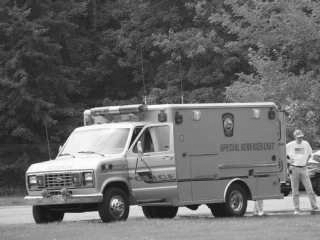
PART’s Special Operations Vehicle presently equipped with 2 meter and 440 communications capability
I recall having a conversation with Bud, (K1PD), way back in the early days of PART. We were speculating about what type of ham radio communications we would like to see permanently mounted in the police station. We thought that an additional 6 meter rig might be worthwhile but at that time we were hard at work to raise enough money for just one 2 meter rig let alone several rigs. I wish Bud were here today to see the great array of amateur rigs and antennas that now reside in our new police station under the auspices of PART. It should be noted that these rigs are in place today due to the extensive efforts of Hugh Maguire (N1QGE). Hugh was instrumental in seeing that ham antennas and coax were installed during the construction of the new police/fire station. He was the key person in securing the Special Operations Vehicle and outfitting it with its present complement of ham radio gear for our use. This vehicle is a converted Westford ambulance that is now painted in police department trim. PART members have been converting it into a mobile communications vehicle for use in emergencies and special communications events. Simultaneous operation on several amateur bands along with direct communications to the Westford Police Department from this special operations vehicle is now possible.
In Conclusion
It seems like a lifetime since those early PART meetings in Chief Connell’s basement. We had great discussions... and some arguments…over just what PART should be. Chief Connell had a vision and a unique vision at that. It was simple in concept, a joining of public service ham radio and a local police department. PART has come a long way since then. Many people have contributed, over the years, to its success and I wish I could acknowledge the contributions of everyone. What a success it has been. Let's hope PART continues to be even more successful in the future.The Original Crew
Many people contributed to the initial beginnings of PART. Listed below are those who helped, during the 1970’s, towards getting PART off the ground and up and running.Joe Connell WA1UYR Bud Hill K1PD
Duffy Dauphinais WA1MKQ Bob Moore
Frank Karkota K1RZK Al Smith WB1DFO
Dick Ferry AB1A Tom Hughes AG1I
Bo Budinger WA1QYM Jim Dossett K1TIH
Sgt Dave Hogg Bob Wallace W1HH
Bob Knowles K1DIR Jack Diamond
Alice Dossett WA1URK Al Dickson
Charles Lucas W1DOH Dave Switzer
Mike Carr WA1QAA Joan Connell
Steve Weinrich WA2QKC Harlan Miller K1TT
Dick Hobecke W1EGY Tom Moore K1KAY